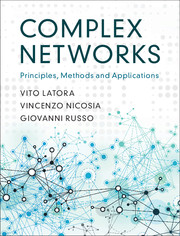Book contents
- Frontmatter
- Dedication
- Contents
- Preface
- Introduction
- Epigraph
- 1 Graphs and Graph Theory
- 2 Centrality Measures
- 3 Random Graphs
- 4 Small-World Networks
- 5 Generalised Random Graphs
- 6 Models of Growing Graphs
- 7 Degree Correlations
- 8 Cycles and Motifs
- 9 Community Structure
- 10 Weighted Networks
- Appendices
- References
- Author Index
- Index
2 - Centrality Measures
Published online by Cambridge University Press: 11 October 2017
- Frontmatter
- Dedication
- Contents
- Preface
- Introduction
- Epigraph
- 1 Graphs and Graph Theory
- 2 Centrality Measures
- 3 Random Graphs
- 4 Small-World Networks
- 5 Generalised Random Graphs
- 6 Models of Growing Graphs
- 7 Degree Correlations
- 8 Cycles and Motifs
- 9 Community Structure
- 10 Weighted Networks
- Appendices
- References
- Author Index
- Index
Summary
Centrality measures allow the key elements in a graph to be identified. The concept of centrality and the first related measures were introduced in the context of social network analysis, and more recently have been applied to various other fields. In this chapter we introduce and discuss the centrality measures most commonly used in the literature to characterise and rank the nodes of a network. We will first focus on measures of node centrality based on the node degree, such as the degree centrality, the eigenvector centrality and the α-centrality.We will then consider centrality measures based on shortest paths, such as the closeness centrality which is related to the average distance of a node from all the other nodes, or the betweenness centrality which counts instead the number of shortest paths a node lies on. As only one possible example of the many potential applications, we introduce a large graph describing a real social system, namely the movie actor collaboration network, and we use it to identify the most popular movie stars. In particular, we will rank the nodes according to different types of centralities and we will compare the various centrality rankings obtained. We conclude the chapter with a discussion on how to extend the measures of centrality from single nodes to groups of nodes.
The Importance of Being Central
In addition to the developments in mathematical graph theory, the study of networks has seen important achievements in some specialised contexts, as for instance in the social sciences. Social networks analysis originated in the early 1920s, and focuses on relationships among social entities, such as communication and collaboration between members of a group, trades among nations, or economic transactions between corporations [308, 278]. This discipline is based on representing a social system as a graph whose nodes are the social individuals or entities, and whose edges represent social interactions. In Figure 2.1 we report three examples of graphs representing different types of interactions, namely marriages between prominent families in Florence (Italy), joint presences at the river in a group of primates, and contacts between terrorists of the September 2001 attacks. Notice that very diverse systems, such as those reported here, can all be well described in terms of graphs.
Information
- Type
- Chapter
- Information
- Complex NetworksPrinciples, Methods and Applications, pp. 31 - 68Publisher: Cambridge University PressPrint publication year: 2017
Accessibility standard: Unknown
Why this information is here
This section outlines the accessibility features of this content - including support for screen readers, full keyboard navigation and high-contrast display options. This may not be relevant for you.Accessibility Information
- 4
- Cited by
